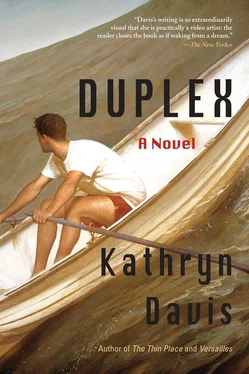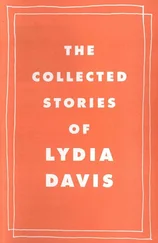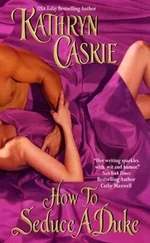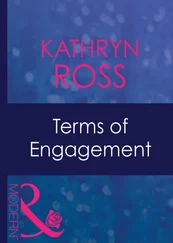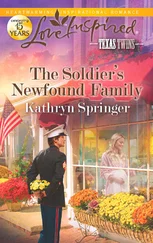The wedding had been a private affair in the Woodard family chapel; at the exact moment Walter slipped the ring onto Mary’s finger she’d been surprised to look up and see Downie standing outside the door, holding the large box that turned out to contain Mrs. Andersen’s sewing machine. Afterward, when she asked him how he’d known she was getting married, he told her he had his ways. “What do you mean?” Mary asked, and he pointed into the woods. The day was ending; shadows darted between the trunks of the fir trees. It was no secret that in recent years the estate had become overrun with wild animals, the gray hares chief among them. Mary had to clear away their nests and droppings before the ceremony could begin. “They do whatever I ask,” Downie said, calling one to him with a little whistle and petting it between its long gray ears. “Just don’t get too close. They know how to bite.” Later on he gave her Mrs. Andersen’s dress dummy too, but as Mary had grown older she’d never developed breasts as large as Mrs. Andersen’s had been. Eventually the dummy ended up in the basement along with her paintings.
The dummy reminded Mary of the time before art school when she was living in number 47 with her parents. She thought of her father asleep on the couch, her mother watching him silent and impenetrable, waiting to accommodate him — to accommodate anyone — like the dummy. Mary’s parents had to have moved to the street from somewhere else at some point, though Mary was pretty sure she’d never lived anywhere until then except inside her mother. Before that she was nothing, or something that had nothing to do with her, a wasp caught in a curtain. She could hear the sound of buzzing and she could see a face close to hers, staring. Mary couldn’t remember what it reminded her of, but she knew it reminded her of something from so long ago it had to have been before she lived in her mother. A wall of snow slid from the roof and landed with a thump like someone had thrown down a dead body. It was night, it was day. She drew back the branches and looked though the opening. The sun crept up the pane of the sky and then summer came. Eddie gave her a kiss.
They were sitting on the damp cement at the bottom of the steps outside her cellar door. Honeysuckle bushes that grew above them blocked the light; a large black ant crawled off the cement onto her foot. Eddie asked Mary if she would show him her underpants and she did, but that was all. They were white cotton, like all of her underpants. She showed him how to get the drop of honey out of the honeysuckle by pulling off the flower. They couldn’t have been more than five.
From where she sat sewing, Mary could see the copper-colored watery bottom layer of her painting, as well as the black antlike gleam of the baby grand piano Walter had given her for their anniversary. “Oh, dear. Oh, Mary,” he said when she burst into tears. “You used to play. Oh, Mary, I’m so sorry.”
The pink material was for the maternity blouse she was making — not for herself but for Cindy XA, who had come by one afternoon last week to tell Mary she was pregnant. Cindy had been wearing a sheath sundress that showed off what celebrities called their “bump.” She was still with Roy Duffy and had taken his last name even though they’d never bothered to get married; the Duffys had a nice house near the ball field where Roy coached the high school baseball team. Mary knew his baby wasn’t growing inside Cindy; the appliance being used was related to the one Mrs. Darling had observed the robots use for eating and drinking, a sophisticated compartment that was able to transform matter like milk or sperm or crackers into electrical energy. Roy had to know the baby would look nothing like him. Most babies produced this way started out looking like hand grenades and were just as likely to explode.
Walter didn’t eat much but, unlike the robots, he did eat, and he had nothing but praise for Mary’s cooking. Every morning he drove off to work in the same silver-gray car that had appeared on Mary’s street when she was a girl. Where did he go? The world kept him busy. Some days to the water tower where he took care of paperwork, which for some reason he had a lot of, some days farther than that. Some days he went back to the street where he first saw Mary. He had unfinished business there. Usually he came home in the early evening for dinner.
It was summer, golden summer, the roses in full bloom, the pieces of sky Mary could see through the trunks and limbs and lightly trembling leaves of the trees outside the windows blue like lapis lazuli. When a person wore it as an adornment it signified truthfulness, but in a sky it signified nothing. A little breeze, the smell of grass, a few bugs, that was it. She held up the blouse and regarded her handiwork. It could certainly use something more, some white rickrack around the hem. She could use something more. Something along the lines of some beautiful golden whiskey in a small, clear glass. She and Eddie used to have the best time together, drinking whiskey in the girls’ bathroom at school. OK, OK, maybe they’d had a problem. Eddie is dead and gone, said the rose bushes when Mary walked past them to get the mail. No he isn’t, said the sewing machine. He might as well be, Mary thought. While she’d been in art school boiling the skins of dead rabbits to make glue, Eddie had been becoming famous. His nickname was the Booster. This was because he helped the Rockets achieve liftoff, Downie explained when Mary looked confused. All the women were madly in love with him. They had formed a fan club and for a while after he got hurt and was on the DL they tried to visit him before giving up in frustration. No one seemed to know where he was.
Tonight there would be tuna-noodle casserole for dinner; it was already sitting in the oven waiting for the oven to be turned on, the ingredients thoroughly mixed and topped with cornflakes. The bottle was in the drinks cabinet in the living room, on top of which Walter had put the globe of the known world. Sometimes in the evening he would stand above the globe and tap it lightly with his finger. He would set the globe spinning and then he would begin talking to himself. Though he talked softly, Mary could tell by the cadence of his speech that he was making plans.
All of a sudden for no apparent reason the sewing machine stopped. “Hey!” she said. When something like this occurred it could be a huge problem far away; it could be a small problem close to home. She awakened the console, checking for the emergency signal. To the sound of laughter, a man punched another man in the nose. Mary released the presser foot to remove the blouse but the blouse refused to budge. It wasn’t until she looked under the slide plate and found an enormous snarl of pink thread all around the bobbin that she got up to pour herself a glass of whiskey. Her insides looked exactly like this, Mary knew. The doctor had told her a reproductive organ was busy growing outside itself, sending threads of itself wherever it wasn’t supposed to. As long as it kept doing this she could never have another baby.
While Mary got drunk, the sorcerer was driving by the vacant lot at the foot of her old street. He could see Miss Vicks watching him from where she sat on one of the three benches the community association had placed there, one on each side of the lot to make it seem less vacant; as usual she was holding a leash that had a red dog attached to it. The lot formed an isosceles triangle with Miss Vicks’s bench situated at the midpoint of a long side, facing the end of the street nearest her house and the house where Mary’s parents used to live. For a while the house had been uninhabited and then a new family moved in with three small boys and a parakeet. Parakeets seemed to do well on the street. Aside from the house attached to number 37, houses there never stayed empty long — it was a desirable neighborhood.
Читать дальше
